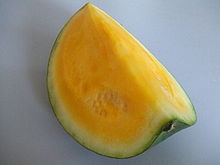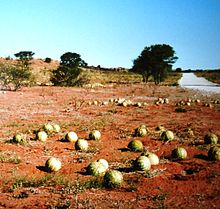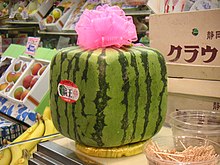Watermelon
| Watermelon | ||||||||||||
|---|---|---|---|---|---|---|---|---|---|---|---|---|

Watermelon ( Citrullus lanatus ) |
||||||||||||
| Systematics | ||||||||||||
|
||||||||||||
| Scientific name | ||||||||||||
| Citrullus lanatus | ||||||||||||
| ( Thunb. ) Matsum. & Nakai |
The watermelon ( Citrullus lanatus ), also called Angurie , Arbuse , Pasteke and Citrull Cucumber , is a crop that originated in Africa and is now cultivated in warm regions around the world. The wild form is also called the tsamma melon .
description
The watermelon is a prostrate to climbing, annual , herbaceous plant . The shoot axes are thin, angular, furrowed and sticky hairy. They have branched tendrils . Most varieties, like the wild forms, are heavily branched and can grow up to ten meters long. Some dwarf watermelon varieties have shortened internodes and grow rather bushy. The root system is extensive, but mostly close to the surface.
The leaves are pinnate, which makes them different from the other cultivated cucurbits . They are stiffly haired on both sides.
The species is single sexed ( monoecious ). The flowers stand individually in the axils of the upper leaves. They are yellow and less noticeable than the flowers of most other cucurbits. The color is light yellow, sometimes veined green. The corolla lobes are around 15 millimeters long, blunt and spread out.
The fruit , also called watermelon itself , is usually 20 to 60 centimeters long and spherical to oblong or cylindrical armored berries . The fruit rind is one to four centimeters thick and hard, but not durable. The color is light to dark green, monochrome, striped or marbled. The pulp tastes sweet.
The number of chromosomes is 2n = 22.
Most varieties have red flesh, but there are also green, orange, yellow, and white varieties, as well as land races. The seeds vary in color (black, brown, red, green, white), shape and size; the characteristics can be used to identify the varieties.
Average composition
The composition of watermelons naturally fluctuates, both depending on the variety and the environmental conditions (soil, climate) as well as the cultivation technique (fertilization, plant protection).
Details per 100 g of edible portion:
|
|
|
1 mg = 1000 µg
The physiological calorific value is 152 kJ (= 36 kcal ) per 100 g of edible portion.
distribution
The wild forms originally come from tropical West Africa and not, as long assumed, from arid South Africa. Today the wild forms are widespread in central Africa . The plants are relatively drought resistant and grow best in fertile, sandy soil in hot, sunny, dry locations.
The cultivated forms are cultivated today worldwide in the tropical and subtropical areas. In the areas where the watermelon is grown, it can also grow wild. This is especially the case in Madagascar and Australia . In parts of Western Australia, it is even considered a nuisance. In Austria it seldom occurs on ruderal sites , especially landfills, which are inconsistently overgrown in the warm climates.
Systematics
Two varieties are distinguished within the species:
- Citrullus lanatus var. Lanatus is the cultivated watermelon
- Citrullus lanatus var. Citroides (LH Bailey) Mansf. includes the wild forms.
Citrullus lanatus var. Lanatus
The fruits of the cultivated watermelon can weigh up to 100 kg, but mostly they weigh 4 to 25 kg. There are special "refrigerator" types that weigh only around one kilogram, so they fit comfortably in a refrigerator. One of these varieties is 'Sugar Baby' with small, dark green, spherical fruits, which has been on the market since 1956. Varieties bred in the USA but also widespread in Africa and Asia are 'Charleston Gray' and 'Crimson Sweet'. 'Accra', 'Anokye' and 'Volta' are typical African varieties, 'Arka Jyoti' and 'Tarbuj' are Indian.
Seedless varieties have been able to be produced since Kihara discovered in 1951 that triploid watermelons produce virtually no seeds. For this purpose, tetraploid plants are artificially created, which serve as mother plants and are pollinated with pollen from diploid plants. The resulting triploid F 1 hybrids are sterile, but form the seedless fruits when pollinated.
Citrullus lanatus var. Citroides
The wild form is also called tsamma melon or lemon melon. The fruits have white or light green flesh. In addition to the bitter wild forms, there are also cultivated forms that taste stale to bitter. The fruit rind is pickled or canned, the rest is fed to the cattle. The seeds are large and of different colors. The seed yield can be between 500 kg and 700 kg per hectare.
In Africa it is often called egusi , but other species also bear this name. The seeds, which are not bitter, are roasted, eaten or ground into flour. The oil from the seeds is used for cooking, and the protein-rich press cake is used to make fried seed balls. Local land races are 'Aketewa' and 'Nerri' in Ghana and 'Bara' and 'Serewe' in Nigeria.
Economical meaning
In 2018, according to the Food and Agriculture Organization FAO, 103,931,336 t of watermelons were harvested worldwide.
The following table gives an overview of the 20 largest producers of watermelons worldwide, which produced a total of 82.0% of the total.
| rank | country | Quantity (in t ) |
rank | country | Quantity (in t) |
|
|---|---|---|---|---|---|---|
| 1 |
|
62,803,768 | 11 |
|
1,472,459 | |
| 2 |
|
4,113,711 | 12 |
|
1,248,613 | |
| 3 |
|
4,031,174 | 13 |
|
1,200,104 | |
| 4th |
|
2,520,000 | 14th |
|
1,092,401 | |
| 5 |
|
2,240,796 | 15th |
|
742.375 | |
| 6th |
|
2,095,757 | 16 |
|
641.784 | |
| 7th |
|
1,969,954 | 17th |
|
634.491 | |
| 8th |
|
1,836,959 | 18th |
|
630.920 | |
| 9 |
|
1,771,051 | 19th |
|
581,564 | |
| 10 |
|
1,483,255 | 20th |
|
548,649 | |
| remaining countries | 10,271,551 |
In 2018, a total of 6,204,007 tons were harvested in Europe. The largest producers in the EU were Spain, Greece and Italy.
In 2018, 3,241,239 hectares of production area were planted with watermelons worldwide. The average yield per hectare was 320,653 hg / ha, which corresponds to 32.1 t / ha.
use
The fruits are eaten as refreshing and thirst-quenching fruit. In the Kalahari and other arid regions of Africa, it was an important source of water for people for centuries. Most of the time the fruits are eaten raw, and sometimes cooked in Africa. The bark can be pickled or candied. In the southern areas of the former Soviet Union , the juice of the fruit is fermented into an alcoholic drink or boiled down into a sweet syrup.
The seeds are ground in India and baked into bread. In the Middle East, the seeds are eaten roasted. In China , where the focus is on the use of seeds, varieties with extra-large seeds have been bred. Ootanga oil or watermelon kernel oil , which is mainly used as a cosmetic additive and less often as salad oil and lamp oil , can be extracted from the seeds . Also in the European medicine of the Middle Ages the seeds ( semina citrulli ) were used as an excess "phlegm" laxative.
hazards
Human pathogenic germs can (for example, from the feces of wild animals derived) in plants commonly roots penetrate stem leaves, shoots and fruits, infect and multiply there. Feeding or sucking stings by insects can also be entry points.
According to a press release from the Federal Institute for Risk Assessment (BfR), watermelons stored for a long time can transmit dangerous pathogens such as salmonella , listeria or EHEC (enterohaemorrhagic Escherichia coli). If the outer shell is contaminated with pathogens during production, transport or storage, these pathogens can infect the low-acid pulp when cut open and will multiply relatively quickly if stored too warm or too long. “Consumers should therefore eat pre-cut melons quickly or refrigerate them to protect against infection.” Pregnant women, small children, the elderly and the sick should avoid eating cut melons that have been kept for several hours at room temperature. In 2011, at least 147 people in the United States contracted Listeria monocytogenes after consuming contaminated cantaloupe ; as a result, 33 people died and a pregnant woman suffered a miscarriage. Consumption of imported watermelons in late 2011 triggered a salmonella outbreak in Germany, the UK and Ireland.
history
The fruits were originally collected for the nutritious seeds, since the flesh of the wild forms is bitter. It is not known whether non-bitter forms were read out at that time. The first cultivated watermelons are from around 2000 BC. Known from ancient Egypt and western Asia. It spread quickly over Central Asia and India, 1000 BC. It was also grown in China and southern Russia. For a long time it was mainly grown in hot and dry areas, i.e. in the tropics and the Mediterranean area. Today it is also grown in the humid tropics. The watermelon is not mentioned by Roman authors such as Pliny or Columella , nor is there a uniform name for the species in the Romance languages. This indicates a relatively late introduction of the watermelon to Europe. Linguistic studies suggest that it was introduced in southwest Europe by the Arabs, and in southeast Europe only through the Ottoman expansion. It was never grown in Northern Europe, where the name is usually composed of the terms for water and melon (Czech, all Germanic languages).
The cubic watermelon was invented by the Japanese graphic artist Tomoyuki Ono and exhibited in a gallery in the Ginza district of Tokyo in August 1978 . After the exhibition, it should be for the equivalent of 400 Austria. Schilling (57 D-Mark, today approx. 28.50 euros) are sold. She applied for a patent for it in Japan in March 1977 and in the United States in February 1978.
Common names
The other German-language trivial names Angurie, Citrulle, Wasserpäddem ( Siebenbürgen ) exist or existed for the watermelon .
literature
- RW Robinson, DS Decker-Walters: Cucurbits . CAB International, Wallingford 1997, pp. 84-88. ISBN 0-85199-133-5
Movies
- Colorful, healthy and sometimes round, watermelon - broccoli , arte documentation, 2015
Individual evidence
- ↑ Overview by Gisela Schmidt , "Feinschmecker-Fahrt: Guten Appetit", on vegetarismus.ch
- ↑ Citrullus lanatus at Tropicos.org. In: IPCN Chromosome Reports . Missouri Botanical Garden, St. Louis
- ↑ German Research Institute for Food Chemistry (DFA) Garching (Hrsg.): Food table for practice . The little souci · specialist · herb. 4th edition. Wissenschaftliche Verlagsgesellschaft, Stuttgart 2009, ISBN 978-3-8047-2541-6 , p. 385 .
- ↑ "The Watermelon Family Ties", Süddeutsche Zeitung, accessed on October 30, 2014 ( page no longer available , search in web archives ) Info: The link was automatically marked as defective. Please check the link according to the instructions and then remove this notice.
- ^ William Thomas Parsons, Eric George Cuthbertson: Noxious Weeds of Australia , 2nd. Edition, CSIRO Publishing, Collingwood, Victoria 2001, ISBN 0643065148 , pp. 407-408 (Retrieved April 17, 2014).
- ^ Manfred A. Fischer , Karl Oswald, Wolfgang Adler: Excursion flora for Austria, Liechtenstein and South Tyrol. 3rd, improved edition. State of Upper Austria, Biology Center of the Upper Austrian State Museums, Linz 2008, ISBN 978-3-85474-187-9 .
- ↑ a b c Crops> Watermelons. In: Official FAO production statistics for 2018. fao.org, accessed on May 11, 2020 .
- ↑ Irene Esteban Cuesta: Investigations on the endogenous microbial contamination of melons (Cucumis Melo) , Department of Veterinary Science at the Faculty of Veterinary Medicine at the Ludwig Maximilians University in Munich, Chair for Food Safety, Munich 2016, PDF file
- ↑ a b c Melons can transmit pathogenic germs , August 9, 2013
- ↑ M. Pitrat, M. Chauvet, C. Foury: Diversity, history and production of cultivated cucurbits . In: K. Abak, S. Büyükalaca: Proceedings of the First International Symposium on Cucurbits . Acta Horticultae, Volume 492, 1999. ISSN 0567-7572
- ↑ Melons now in a square . In: Arbeiter-Zeitung . Vienna August 21, 1978, p. 5 ( Arbeiter-zeitung.at - the open online archive - digitized).
- ↑ Patent JPS53107954 : MOLDED FRUITS AND METHOD AND ITS FLOWER cultivating MOLD DEVICE. Filed March 3, 1977 , published September 20, 1978 , inventor: Tomoyuki Ono (full text).
- ↑ Patent US4187639 : Molding process for a natural fruit of a fruit-tree or vegetable, a molding frame therefor and molded above fruit. Applied on February 17, 1978 , published February 12, 1980 , inventor: Tomoyuki Ono (full text).
- ^ Georg August Pritzel , Carl Jessen : The German folk names of plants. New contribution to the German linguistic treasure. Philipp Cohen, Hannover 1882, p. 120 ( online ).
Web links








